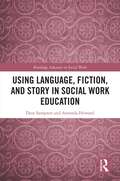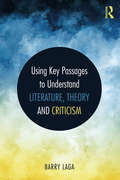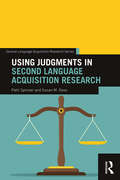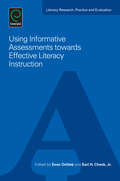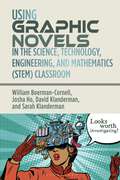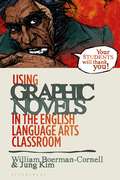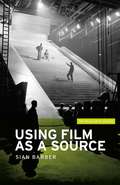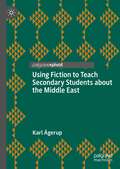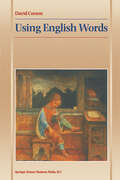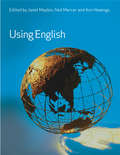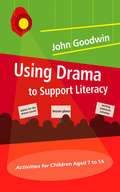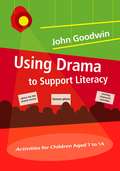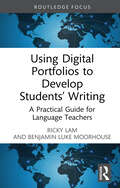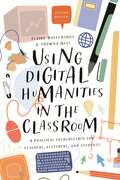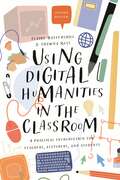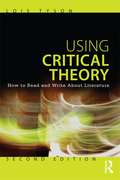- Table View
- List View
Using Language, Fiction, and Story in Social Work Education (Routledge Advances in Social Work)
by Dara Sampson Amanda HowardThis book provides an accessible, research-informed text for social work educators, students, and practitioners interested in the use of story to engender the connection of human experiences with ideas, theories, and skills. A broad lens is also taken to the ways in which fiction has been used as a teaching tool in other degrees, ranging from medicine to engineering to philosophy and economics. Although the research explored is social work specific, this text has applicability for any educator looking for creative methods to teach complex theories, skills, and concepts. Showing how fiction can be used in social work education, it explains why story matters to social work and how fiction can emulate these stories, as well as the capacity of fiction to evoke empathy. Ways in which educators can enlist fiction to create a ‘safe space’ for the exploration of complex emotional terrain are explored, as are the ways in which a community of practice can be created through fiction. Woven within the end of every chapter are some practice examples and author conversations which work to locate the research into a practice context. The text concludes with examples of how fiction has been effectively utilised by the authors, in order to provide a starting point for those interested in exploring this pedagogical approach further.
Using Language, Fiction, and Story in Social Work Education (Routledge Advances in Social Work)
by Dara Sampson Amanda HowardThis book provides an accessible, research-informed text for social work educators, students, and practitioners interested in the use of story to engender the connection of human experiences with ideas, theories, and skills. A broad lens is also taken to the ways in which fiction has been used as a teaching tool in other degrees, ranging from medicine to engineering to philosophy and economics. Although the research explored is social work specific, this text has applicability for any educator looking for creative methods to teach complex theories, skills, and concepts. Showing how fiction can be used in social work education, it explains why story matters to social work and how fiction can emulate these stories, as well as the capacity of fiction to evoke empathy. Ways in which educators can enlist fiction to create a ‘safe space’ for the exploration of complex emotional terrain are explored, as are the ways in which a community of practice can be created through fiction. Woven within the end of every chapter are some practice examples and author conversations which work to locate the research into a practice context. The text concludes with examples of how fiction has been effectively utilised by the authors, in order to provide a starting point for those interested in exploring this pedagogical approach further.
Using Key Passages to Understand Literature, Theory and Criticism
by Barry LagaUsing Key Passages to Understand Literature, Theory and Criticism is a completely fresh and innovative approach to teaching and learning literary theory: using short passages of theory to make sense of literary and cultural texts. It focuses on the key concepts that help readers understand literature and cultural events in new and provocative ways. Covering a wide variety of iconic and contemporary theorists, the book offers a broad chronological and global overview, including thirty passages from theorists such as Viktor Shklovsky, Roland Barthes, Judith Butler, Diana Fuss, Jean Baudrillard, Kwame Anthony Appiah, Michel Foucault, Monique Wittig, and Eve Sedgwick. Built on the premise that scholars use theory pragmatically, Using Key Passages to Understand Literature, Theory and Criticism identifies problems, puzzles, and questions readers may encounter when they read a story, watch a film, or look at artwork. It explains, in detail, thirty concepts that help readers make sense of these works and invites students to apply the concepts to a range of writing and research projects. The textbook concludes by helping students read theory with an eye on finding productive passages and writing their own “theory chapter,” signaling a shift from student as critic to student as theorist. Used as a main text in introductory theory courses or as a supplement to any literature, film, theater, or art course, this book helps students read closely and think critically.
Using Key Passages to Understand Literature, Theory and Criticism
by Barry LagaUsing Key Passages to Understand Literature, Theory and Criticism is a completely fresh and innovative approach to teaching and learning literary theory: using short passages of theory to make sense of literary and cultural texts. It focuses on the key concepts that help readers understand literature and cultural events in new and provocative ways. Covering a wide variety of iconic and contemporary theorists, the book offers a broad chronological and global overview, including thirty passages from theorists such as Viktor Shklovsky, Roland Barthes, Judith Butler, Diana Fuss, Jean Baudrillard, Kwame Anthony Appiah, Michel Foucault, Monique Wittig, and Eve Sedgwick. Built on the premise that scholars use theory pragmatically, Using Key Passages to Understand Literature, Theory and Criticism identifies problems, puzzles, and questions readers may encounter when they read a story, watch a film, or look at artwork. It explains, in detail, thirty concepts that help readers make sense of these works and invites students to apply the concepts to a range of writing and research projects. The textbook concludes by helping students read theory with an eye on finding productive passages and writing their own “theory chapter,” signaling a shift from student as critic to student as theorist. Used as a main text in introductory theory courses or as a supplement to any literature, film, theater, or art course, this book helps students read closely and think critically.
Using Judgments in Second Language Acquisition Research (Second Language Acquisition Research Series)
by Patti Spinner Susan M. GassSynthesizing the theory behind and methodology for conducting judgment tests, Using Judgments in Second Language Acquisition Research aims to clarify the issues surrounding this method and to provide best practices in its use. The text is grounded on a balanced and comprehensive background of the usage of judgment data in the past up through its present-day applications. SLA researchers and graduate students will find useful a chapter serving as a "how-to" guide for a variety of situations to conduct research using judgments, including ways to optimize task design and examples from successful studies. Lucid and practical, Using Judgments in Second Language Acquisition Research offers guidance on a method widely used by SLA researchers, both old and new to the field.
Using Judgments in Second Language Acquisition Research (Second Language Acquisition Research Series)
by Patti Spinner Susan M. GassSynthesizing the theory behind and methodology for conducting judgment tests, Using Judgments in Second Language Acquisition Research aims to clarify the issues surrounding this method and to provide best practices in its use. The text is grounded on a balanced and comprehensive background of the usage of judgment data in the past up through its present-day applications. SLA researchers and graduate students will find useful a chapter serving as a "how-to" guide for a variety of situations to conduct research using judgments, including ways to optimize task design and examples from successful studies. Lucid and practical, Using Judgments in Second Language Acquisition Research offers guidance on a method widely used by SLA researchers, both old and new to the field.
Using Informative Assessments towards Effective Literacy Instruction (Literacy Research, Practice and Evaluation #1)
by Evan Ortlieb Earl H. CheekUsing Informative Assessments towards Effective Literacy Practices offers research driven solutions to improving student literacy success through the exploration of advancements in literacy assessment and instruction. As the first volume in the series, Literacy Research, Practice, and Evaluation, distinguished authors share a comprehensive portrayal of why assessments are necessary, how to select appropriate assessments, and how to effectively use data for curricular planning and instruction. By addressing concerns before, during, and after literacy instruction with research-based instructional techniques embedded within the chapters, readers garner rich perspectives on literacy assessment that can immediately impact their effective teacher practices. This text is founded on the principle that praxis, or the combination of research with practice, should be the ultimate goal of educational missions and visions alike. It provides a fresh examination of current issues and trends in literacy assessment salient to novice and experienced educators alike.
Using Graphic Novels in the STEM Classroom
by Professor William Boerman-Cornell Josha Ho Professor David Klanderman Dr Sarah KlandermanThis book provides everything STEM teachers need to use graphic novels in order to engage students, explain difficult concepts, and enrich learning. Drawing upon the latest educational research and over 60 years of combined teaching experience, the authors describe the multimodal affordances and constraints of each element of the STEM curriculum. Useful for new and seasoned teachers alike, the chapters provide practical guidance for teaching with graphic novels, with a section each for Science, Technology, Engineering, and Mathematics. An appendix provides nearly 100 short reviews of graphic novels arranged by topic, such as cryptography, evolution, computer coding, skyscraper design, nuclear physics, auto repair, meteorology, and human physiology, allowing the teacher to find multiple graphic novels to enhance almost any unit. These include graphic novel biographies of Stephen Hawking, Jane Goodall, Alan Turing, Rosalind Franklin, as well as popular titles such as T-Minus by Jim Ottaviani, Brooke Gladstone's The Influencing Machine, Theodoris Andropoulos's Who Killed Professor X, and Gene Yang's Secret Coders series.
Using Graphic Novels in the STEM Classroom
by Professor William Boerman-Cornell Josha Ho Professor David Klanderman Dr Sarah KlandermanThis book provides everything STEM teachers need to use graphic novels in order to engage students, explain difficult concepts, and enrich learning. Drawing upon the latest educational research and over 60 years of combined teaching experience, the authors describe the multimodal affordances and constraints of each element of the STEM curriculum. Useful for new and seasoned teachers alike, the chapters provide practical guidance for teaching with graphic novels, with a section each for Science, Technology, Engineering, and Mathematics. An appendix provides nearly 100 short reviews of graphic novels arranged by topic, such as cryptography, evolution, computer coding, skyscraper design, nuclear physics, auto repair, meteorology, and human physiology, allowing the teacher to find multiple graphic novels to enhance almost any unit. These include graphic novel biographies of Stephen Hawking, Jane Goodall, Alan Turing, Rosalind Franklin, as well as popular titles such as T-Minus by Jim Ottaviani, Brooke Gladstone's The Influencing Machine, Theodoris Andropoulos's Who Killed Professor X, and Gene Yang's Secret Coders series.
Using Graphic Novels in the English Language Arts Classroom
by William Boerman-Cornell Jung KimThere is an increasing trend in teachers using graphic novels to get their students excited about reading and writing, using both original stories and adaptations of classic works by authors such as Homer, Shakespeare, and the Brontes. However, there is surprisingly little research available about which pedagogies and classroom practices are proven to be effective. This book draws on cutting-edge research, surveys and classroom observations to provide a set of effective methods for teaching with graphic novels in the secondary English language arts classroom. These methods can be applied to a broad base of uses ranging from understanding literary criticism, critical reading, multimodal composition, to learning literary devices like foreshadowing and irony.The book begins by looking at what English language arts teachers hope to achieve in the classroom. It then considers the affordances and constraints of using graphic novels to achieve these specific goals, using some of the most successful graphic novels as examples, including Maus; Persepolis; The Nameless City; and American Born Chinese and series such as Manga Shakespeare. Finally, it helps the teacher navigate through the planning process to figure out how to best use graphic novels in their own classroom. Drawing on their extensive teaching experience, the authors offer examples from real classrooms, suggested lesson plans, and a list of teachable graphic novels organized by purpose of teaching.
Using Graphic Novels in the English Language Arts Classroom
by William Boerman-Cornell Jung KimThere is an increasing trend in teachers using graphic novels to get their students excited about reading and writing, using both original stories and adaptations of classic works by authors such as Homer, Shakespeare, and the Brontes. However, there is surprisingly little research available about which pedagogies and classroom practices are proven to be effective. This book draws on cutting-edge research, surveys and classroom observations to provide a set of effective methods for teaching with graphic novels in the secondary English language arts classroom. These methods can be applied to a broad base of uses ranging from understanding literary criticism, critical reading, multimodal composition, to learning literary devices like foreshadowing and irony.The book begins by looking at what English language arts teachers hope to achieve in the classroom. It then considers the affordances and constraints of using graphic novels to achieve these specific goals, using some of the most successful graphic novels as examples, including Maus; Persepolis; The Nameless City; and American Born Chinese and series such as Manga Shakespeare. Finally, it helps the teacher navigate through the planning process to figure out how to best use graphic novels in their own classroom. Drawing on their extensive teaching experience, the authors offer examples from real classrooms, suggested lesson plans, and a list of teachable graphic novels organized by purpose of teaching.
Using film as a source (IHR Research Guides)
by Sian BarberThis book is a hands-on study skills guide that explores how film and moving image can be used as sources. It is aimed at those who want to use film and moving image as the basis for research and offers advice on research methods, theory and methodology, archival work and film-based analysis. It draws on the disciplines of film and history to offer advice for students and researchers in these fields. The book includes sections on working with different kinds of moving images, how to explore visual sources, how to undertake film-related research and how to use film theory. In addition to providing detailed case studies, the guide also offers advice on research, writing and studying, creating a methodology, visiting archives, accessing material and exploring films from a historical perspective. The guide's focus is on good research practice, whether it be conducting an interview, visiting an archive, undertaking textual analysis or defining a research question.
Using film as a source (IHR Research Guides)
by Sian BarberThis book is a hands-on study skills guide that explores how film and moving image can be used as sources. It is aimed at those who want to use film and moving image as the basis for research and offers advice on research methods, theory and methodology, archival work and film-based analysis. It draws on the disciplines of film and history to offer advice for students and researchers in these fields. The book includes sections on working with different kinds of moving images, how to explore visual sources, how to undertake film-related research and how to use film theory. In addition to providing detailed case studies, the guide also offers advice on research, writing and studying, creating a methodology, visiting archives, accessing material and exploring films from a historical perspective. The guide's focus is on good research practice, whether it be conducting an interview, visiting an archive, undertaking textual analysis or defining a research question.
Using Fiction to Teach Secondary Students about the Middle East
by Karl ÅgerupThis book draws on empirical studies of classrooms teaching The Sirens of Baghdad by Yasmina Khadra to demonstrate how novels can effectively help achieve learning objectives related to intercultural understanding and global citizenship. By combining theoretical and empirical research, the book offers insights into the most effective ways to discuss cross-cultural literature with upper secondary students who have grown up in the Western world. It outlines how, where, and why such literature can enhance students' understanding of different cultures and make them more globally aware citizens.
Using English Words
by P. CorsonUsing English Words examines the impact that the life histories of people have on their vocabulary. Its starting point is the taken-for-granted fact that the vocabulary of English falls into two very different sections. Randolph Quirk mentions this striking incompatibility between the Anglo Saxon and the Latinate elements in English: "the familiar homely-sounding and typically very short words" that we learn very early in life and use for most everyday purposes; and "the more learned, foreign-sounding and characteristically rather long words" (1974, p. 138). It is mainly the second type of word that native speakers start learning relatively late in their use of English, usually in the adolescent years of education, and keep on learning. It is mainly the one type of word, rather than the other, that ESL/ EFL students have more difficulty with, depending on their language background. This book shows how discursive relations, outside education, 'position' people through their vocabularies. Some are prepared for easy entry into lifetime prospects of relative privilege and educational success, while others are denied entry. In writing this book, I share an aim with other writers who observe the many discontinuities that exist between discursive practices in communities outside schools, and the discursive demands that schools make (e. g. Hamilton et a1. [19931, Heath [1983], Luke [19941, Philips [1983], Romaine [1984], Scollon & Scollon [1981]).
Using English
by Janet MaybinUsing English provides an invaluable introduction to the study of English for students of language and linguistics. It examines the way in which the English language is used today in different contexts and in many parts of the world, by both native and non-native speakers. Issues of language use in speech and writing, in work and play, and in persuading and informing are explored and illustrated with data and readings from around the English-using world. The reader is introduced to the adaptations and variations in English language use and to debates relating to how these are perceived and evaluated by different groups of users. For this second edition, key material from the earlier bestselling book, Using English: From Conversation to Canon, has been reorganized and updated, and entirely new material has been introduced. This new content is based on recent research in the field, as well as on contemporary thinking about how speakers and writers use the English language to accomplish a huge range of purposes in a variety of linguistic and cultural settings. Drawing on The Open University's wide experience of writing accessible and innovative texts, this book: explains basic concepts, easily located through a comprehensive index, includes contributions by experts in the field, such as Mike Baynham, Adrian Beard, Guy Cook, Sharon Goodman, Almut Koester, Janet Maybin and Neil Mercer, contains a range of source material and commissioned readings to supplement chapters.
Using English
by Janet Maybin Neil Mercer Ann HewingsUsing English provides an invaluable introduction to the study of English for students of language and linguistics. It examines the way in which the English language is used today in different contexts and in many parts of the world, by both native and non-native speakers. Issues of language use in speech and writing, in work and play, and in persuading and informing are explored and illustrated with data and readings from around the English-using world. The reader is introduced to the adaptations and variations in English language use and to debates relating to how these are perceived and evaluated by different groups of users. For this second edition, key material from the earlier bestselling book, Using English: From Conversation to Canon, has been reorganized and updated, and entirely new material has been introduced. This new content is based on recent research in the field, as well as on contemporary thinking about how speakers and writers use the English language to accomplish a huge range of purposes in a variety of linguistic and cultural settings. Drawing on The Open University's wide experience of writing accessible and innovative texts, this book: explains basic concepts, easily located through a comprehensive index, includes contributions by experts in the field, such as Mike Baynham, Adrian Beard, Guy Cook, Sharon Goodman, Almut Koester, Janet Maybin and Neil Mercer, contains a range of source material and commissioned readings to supplement chapters.
Using Drama to Support Literacy: Activities for Children Aged 7 to 14
by John Goodwin'This book will be a welcome, practical addition to the repertoires of teachers of children aged 7-11 who are looking for inspiration and relevance in their teaching of writing skills' - Speaking English `For the drama novice, this is the book to buy. It reveals drama's power, maps the route to success, and empowers the reader to follow' - Literacy Time `All activities are inspiring and imaginative, and the written activities that follow them are varied and interesting...this book will prove useful, especially in the upper primary and middle school' - English Drama Media Using ideas and activities already tried and tested in the classroom, this book shows practitioners how imaginative drama lessons and activities can be used to help encourage and improve children's writing, speaking and listening skills. Perfect for the person who might not be used to leading drama-based activities, this book takes a step-by step approach that will help even the most daunted teacher tackle drama with confidence. Also included are: - ideas for suitable writing and drama activities - advice on lesson planning - list of useful resources - examples of children's work and teachers' comments Class teachers, teaching assistants, literacy consultants and drama and English co-ordinators looking for practical, fun drama activities to support literacy will find all the help they need in this book.
Using Drama to Support Literacy: Activities for Children Aged 7 to 14 (PDF)
by John Goodwin'This book will be a welcome, practical addition to the repertoires of teachers of children aged 7-11 who are looking for inspiration and relevance in their teaching of writing skills' - Speaking English `For the drama novice, this is the book to buy. It reveals drama's power, maps the route to success, and empowers the reader to follow' - Literacy Time `All activities are inspiring and imaginative, and the written activities that follow them are varied and interesting...this book will prove useful, especially in the upper primary and middle school' - English Drama Media Using ideas and activities already tried and tested in the classroom, this book shows practitioners how imaginative drama lessons and activities can be used to help encourage and improve children's writing, speaking and listening skills. Perfect for the person who might not be used to leading drama-based activities, this book takes a step-by step approach that will help even the most daunted teacher tackle drama with confidence. Also included are: - ideas for suitable writing and drama activities - advice on lesson planning - list of useful resources - examples of children's work and teachers' comments Class teachers, teaching assistants, literacy consultants and drama and English co-ordinators looking for practical, fun drama activities to support literacy will find all the help they need in this book.
Using Digital Portfolios to Develop Students’ Writing: A Practical Guide for Language Teachers (Routledge Research in Language Education)
by Ricky Lam Benjamin Luke MoorhouseThis book equips pre-service teachers, research postgraduate students, teacher educators, and language specialists with specific knowledge and skills about the principles, research, and applications of digital portfolios within the EFL writing contexts. While most digital portfolio scholarship focuses on higher education, this book targets primary-level and secondary-level school audiences, namely pre-service teachers, teacher educators, and Ministry of Education staff members with a focus on EFL writing. The rationale behind this design is that the published literature on digital portfolios tends to be generic and one-size-fits-all; there has been scant published scholarship about the development of digital portfolio literacy among teachers and pupils, which could enable them to upgrade the teaching and learning of writing in a larger EFL environment. This volume fills this gap by illustrating the why, what, and how aspects of digital portfolios in ten reader-friendly chapters. Guiding educators to enrich their pedagogical repertoire via the portfolio approach, this book emphasises a healthy balance between principles, research, and practice. It is an easy-to-follow guide to setting up digital portfolio systems and coaching pupils to improve writing, ensuring the dissemination of digital portfolios with high fidelity.
Using Digital Portfolios to Develop Students’ Writing: A Practical Guide for Language Teachers (Routledge Research in Language Education)
by Ricky Lam Benjamin Luke MoorhouseThis book equips pre-service teachers, research postgraduate students, teacher educators, and language specialists with specific knowledge and skills about the principles, research, and applications of digital portfolios within the EFL writing contexts. While most digital portfolio scholarship focuses on higher education, this book targets primary-level and secondary-level school audiences, namely pre-service teachers, teacher educators, and Ministry of Education staff members with a focus on EFL writing. The rationale behind this design is that the published literature on digital portfolios tends to be generic and one-size-fits-all; there has been scant published scholarship about the development of digital portfolio literacy among teachers and pupils, which could enable them to upgrade the teaching and learning of writing in a larger EFL environment. This volume fills this gap by illustrating the why, what, and how aspects of digital portfolios in ten reader-friendly chapters. Guiding educators to enrich their pedagogical repertoire via the portfolio approach, this book emphasises a healthy balance between principles, research, and practice. It is an easy-to-follow guide to setting up digital portfolio systems and coaching pupils to improve writing, ensuring the dissemination of digital portfolios with high fidelity.
Using Digital Humanities in the Classroom: A Practical Introduction for Teachers, Lecturers, and Students
by Claire Battershill Shawna RossRooted in the day-to-day experience of teaching and written for those without specialist technical knowledge, this is a new edition of the go-to guide to using digital tools and resources in the humanities classroom. In response to the rapidly changing nature of the field, this new edition has been updated throughout and now features:- A brand-new Preface accounting for new developments in the broader field of DH pedagogy- New chapters on 'Collaborating' and on 'Teaching in a Digital Classroom' - New sections on collaborating with other teachers; teaching students with learning differences; explaining the benefits of digital pedagogy to your students; and advising graduate students about the technologies they need to master- New 'advanced activities' and 'advanced assignment' sections (including bots, vlogging, crowd-sourcing, digital storytelling, web scraping, critical making, automatic text generation, and digital media art)- Expanded chapter bibliographies and over two dozen tables offering practical advice on choosing software programsAccompanied by a streamlined companion website, which has been entirely redesigned to answer commonly asked questions quickly and clearly, this is essential reading for anyone looking to incorporate digital tools and resources into their daily teaching.
Using Digital Humanities in the Classroom: A Practical Introduction for Teachers, Lecturers, and Students
by Claire Battershill Shawna RossRooted in the day-to-day experience of teaching and written for those without specialist technical knowledge, this is a new edition of the go-to guide to using digital tools and resources in the humanities classroom. In response to the rapidly changing nature of the field, this new edition has been updated throughout and now features:- A brand-new Preface accounting for new developments in the broader field of DH pedagogy- New chapters on 'Collaborating' and on 'Teaching in a Digital Classroom' - New sections on collaborating with other teachers; teaching students with learning differences; explaining the benefits of digital pedagogy to your students; and advising graduate students about the technologies they need to master- New 'advanced activities' and 'advanced assignment' sections (including bots, vlogging, crowd-sourcing, digital storytelling, web scraping, critical making, automatic text generation, and digital media art)- Expanded chapter bibliographies and over two dozen tables offering practical advice on choosing software programsAccompanied by a streamlined companion website, which has been entirely redesigned to answer commonly asked questions quickly and clearly, this is essential reading for anyone looking to incorporate digital tools and resources into their daily teaching.
Using Critical Theory: How to Read and Write About Literature
by Lois TysonExplaining both why theory is important and how to use it, Lois Tyson introduces beginning students of literature to this often daunting area in a friendly and approachable style. The new edition of this textbook is clearly structured with chapters based on major theories that students are expected to cover in their studies. Key features include: coverage of major theories including psychoanalysis, Marxism, feminism, lesbian/gay/queer theories, postcolonial theory, African American theory, and a new chapter on New Criticism (formalism) practical demonstrations of how to use these theories on short literary works selected from canonical authors including William Faulkner and Alice Walker a new chapter on reader-response theory that shows students how to use their personal responses to literature while avoiding typical pitfalls new sections on cultural criticism for each chapter new ‘further practice’ and ‘further reading’ sections for each chapter a useful "next step" appendix that suggests additional literary titles for extra practice. Comprehensive, easy to use, and fully updated throughout, Using Critical Theory is the ideal first step for students beginning degrees in literature, composition and cultural studies.
Using Critical Theory: How to Read and Write About Literature
by Lois TysonExplaining both why theory is important and how to use it, Lois Tyson introduces beginning students of literature to this often daunting area in a friendly and approachable style. The new edition of this textbook is clearly structured with chapters based on major theories that students are expected to cover in their studies. Key features include: coverage of major theories including psychoanalysis, Marxism, feminism, lesbian/gay/queer theories, postcolonial theory, African American theory, and a new chapter on New Criticism (formalism) practical demonstrations of how to use these theories on short literary works selected from canonical authors including William Faulkner and Alice Walker a new chapter on reader-response theory that shows students how to use their personal responses to literature while avoiding typical pitfalls new sections on cultural criticism for each chapter new ‘further practice’ and ‘further reading’ sections for each chapter a useful "next step" appendix that suggests additional literary titles for extra practice. Comprehensive, easy to use, and fully updated throughout, Using Critical Theory is the ideal first step for students beginning degrees in literature, composition and cultural studies.
